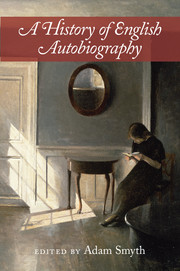Book contents
- Frontmatter
- Dedication
- Contents
- List of contributors
- 1 Introduction: The range, limits, and potentials of the form
- PART 1 AUTOBIOGRAPHY BEFORE ‘AUTOBIOGRAPHY’ (CA. 1300–1700)
- 2 Medieval life-writing: Types, encomia, exemplars, patterns
- 3 Autobiographical selves in the poetry of Chaucer, Gower, Hoccleve, and Lydgate
- 4 The radicalism of early modern spiritual autobiography
- 5 Inscribing the early modern self: The materiality of autobiography
- 6 Re-writing revolution: Life-writing in the Civil Wars
- 7 Money, accounting, and life-writing, 1600–1700: Balancing a life
- PART 2 RELIGION, GENDER, THINGS (CA. 1700–1800)
- PART 3 THE MANY NINETEENTH CENTURIES (CA. 1800–1900)
- PART 4 RELATIONAL LIVES AND FORMS OF REMEMBERING (CA. 1890–1930)
- PART 5 KINDS OF COMMUNITY (CA. 1930-CONTEMPORARY)
- Index
- References
5 - Inscribing the early modern self: The materiality of autobiography
from PART 1 - AUTOBIOGRAPHY BEFORE ‘AUTOBIOGRAPHY’ (CA. 1300–1700)
Published online by Cambridge University Press: 05 March 2016
- Frontmatter
- Dedication
- Contents
- List of contributors
- 1 Introduction: The range, limits, and potentials of the form
- PART 1 AUTOBIOGRAPHY BEFORE ‘AUTOBIOGRAPHY’ (CA. 1300–1700)
- 2 Medieval life-writing: Types, encomia, exemplars, patterns
- 3 Autobiographical selves in the poetry of Chaucer, Gower, Hoccleve, and Lydgate
- 4 The radicalism of early modern spiritual autobiography
- 5 Inscribing the early modern self: The materiality of autobiography
- 6 Re-writing revolution: Life-writing in the Civil Wars
- 7 Money, accounting, and life-writing, 1600–1700: Balancing a life
- PART 2 RELIGION, GENDER, THINGS (CA. 1700–1800)
- PART 3 THE MANY NINETEENTH CENTURIES (CA. 1800–1900)
- PART 4 RELATIONAL LIVES AND FORMS OF REMEMBERING (CA. 1890–1930)
- PART 5 KINDS OF COMMUNITY (CA. 1930-CONTEMPORARY)
- Index
- References
Summary
Even as we write about autobiography before ‘autobiography’, we often still read early modern autobiographical narratives through the lens of generic conventions that reified an introspective, retrospective self. It is equally likely that early modern exemplars will be read through the lens of nineteenth-century print conventions. Many of the earliest print publications of these texts date from nineteenth-century series. These series highlight certain genealogies – of aristocratic families, religious denominations, or local histories – that also shape the ways we read early modern autobiography (Peterson 1993). Imposing a Victorian sensibility on early modern texts, the print revival also effaced early modern material forms.
Two hundred years on, with many of these texts now in archives and rare book libraries, it has taken another wave of scholarly discoveries for us to better understand the range of documentary practices through which early modern autobiographical intentions were realised. Excitingly, contemporary editorial practices (including the examples referenced here) are newly concerned with documenting early modern material forms of inscription, including descriptions and illustrations of the preparation of notebooks, the mise-en-page of composition, the placement of marginal comment, the evidence of authorial revision over time, and the admixtures of autobiography with a range of genres and other authorial hands, even in a single volume. Online transcriptions and digital images are further helping today's readers appreciate the full range of experiment and innovation with early modern forms of autobiography. This chapter focuses on materials and occasions of composition to highlight early modern autobiography's characteristic experimentation with form and function. It argues that we must attend to the processes and material forms of writing if we want to understand fully the constructedness of autobiographies’ shifting relations between writing self and written self.
A signature is a basic inscription of self. But does a signature signify assent? Legal interrogation frames some of the earliest extant English accounts of personal belief. Throughout the English Reformation, an autograph may become the contested crux of conviction. Such was the case for Anne Askew (ca. 1521–1546), a young gentlewoman who attracted the attention of the bishops persecuting Protestant reformers in the court circles of Queen Katherine Parr. Askew was burned at the stake in Smithfield when she was just twenty-five, after having been arraigned for heresy, imprisoned, and tortured.
- Type
- Chapter
- Information
- A History of English Autobiography , pp. 56 - 69Publisher: Cambridge University PressPrint publication year: 2016
References
- 4
- Cited by

